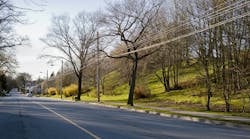Vegetation Management: In Everyone’s Best Interest
The major challenge for utility vegetation managers today is much the same as what we’ve faced since the beginning: we are on other people’s property, and even though we have rights-of-way (ROW), people do not always understand what we need to do and why. It is a constant challenge to educate the public about the safety and reliability risks vegetation can pose to electrical facilities.
On transmission facilities, we usually have clear ROW, but what the utility needs to do may not be accepted. On distribution lines, the ROW may or may not be as clear. Getting cooperation from landowners and governmental agencies, ensuring franchise agreements are correct with cities and working with the U.S. Forest Service to balance its land management concerns with the utility’s needs to protect reliability and public safety all fall into the equation.
Internet-Based Education
Education remains an intensive, on-the-ground focused effort, whether it involves the utility’s foresters or contractors. Scheduling meetings with customers, cities and neighborhood associations has not changed throughout the years and remains a priority.
One area of change is the increasing prevalence and traction utilities are achieving with Internet-based education. We can provide links to associations like the National Arbor Day Foundation or the International Society of
Arboriculture to provide views on the right way to maintain vegetation. Social media is providing new opportunities for contact and education. Avenues like Twitter can provide insights into the public’s attitudes and acceptance of what the utility is doing, making it possible to target education and outreach.
Sharing knowledge about trees provides the opening to work with others regarding utility issues and concerns. Networking with colleagues in the municipal and commercial sectors of arboriculture, attending conferences and participating in the state community forest councils create goodwill and lead to allies in times of controversy.
An Efficient and Effective Program
Storm outage prevention and recovery has always been a major reason we keep trees away from our electrical facilities. A good vegetation management program increases the utility’s ability to withstand storms and minimize damage to the system. If the system is being maintained, it will be more resilient and outages will be more limited. The program will be more cost-effective in the long run.
PacifiCorp management recognizes this and provides appropriate emphasis and budgets for vegetation management. Of course, management challenges us to do things more efficiently, as it is an obligation we have to our ratepayers. Management also recognizes trees are dynamic and deferral of work has a compound inflation factor, with costs going up and more work being necessary to achieve desired conditions.
Safety and Reliability
One valuable lesson learned involved the more strict regulatory clearance requirements in Oregon. We observed the differences between our resiliency there and in states where there were no requirements. We adopted many of the Oregon requirements as uniform throughout our six-state service territory and the resiliency benefits have been significant. Overwhelmingly, safety and reliability drive PacifiCorp’s vegetation management program. We consider regulators with more extensive requirements as our partners and learn from their requirements.
We operate using an integrated vegetation management plan. Pruning is the most common tool on distribution circuits, but tree removal, tree-growth regulators and herbicide work are available for distribution facilities as well as transmission work. Where larger land areas are involved, cover-type conversion is another option to promote plant communities consistent with the use of the ROW. A meadow-type community will never interfere with the transmission line and has the added benefit of enhancing pollinators, songbirds and other sensitive populations.
Increasingly, we see the benefits of environmental stewardship activities that promote diversity and habitat enhancement within our ROW. That said, in some areas, timber species are just fine and help to maintain diverse plant and animal communities. Canyon bottoms are one example. In those areas, our goal is to optimize beneficial uses consistent with maintaining safety and reliability.
Randall H. Miller is director of vegetation management at PacifiCorp. He has a MS degree in urban forestry and is an ISA certified master arborist. He is chair of the Tree Research and Education Endowment (TREE) Fund Board of Trustees and is a past president of the Utility Arborist Association.


